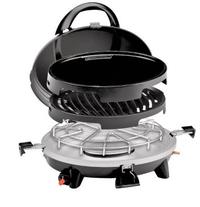Coleman All In One Cooking System
![]()
![]()
![]()
![]()
![]()
![]()
![]()
![]()

Conventional gas barbeques represent just about everything that’s unspeakable about eating outside. Huge, rattling, rusty machines dripping with gobbets of last year’s burger grease subsequently calcified into obsidian stalactites; crawling with eyeless, Pleistocene insects; and connected to enough pressurized hydrocarbons to launch the whole works into low orbit if the igniter fails on the fourth try, they make microwaved TV dinners look quite appetizing by comparison.
This is not to say that grilled food isn’t tasty, or that the aromas of its preparation aren’t savory, tantalizing and ideal for luring most of the local black bears into viewing range. I’ve long felt, however, that the whole experience would be somewhat more prepossessing if the resulting food didn’t include a substantial corroded iron component.
The Coleman All In One Cooking System – also sold as the Coleman Propane Cooking Station if you frequent select Canadian automobile parts dealers – is a gas barbeque for rustic chefs who can think outside the box. That would be the metal-lidded box in the back yard teetering on wobbly legs and encrusted with tree sap and other unspeakable substances.
Having a footprint about the size of a large dinner plate, the All In One Cooking System is intrinsically portable. As such, it can reside indoors when it’s not actually cooking something, and forego the atmospheric and wildlife-related degradation that besets its larger and more primitive cousins. Those parts of it which come in contact with food are small enough to repair to a dishwasher, allowing them to be free of carbonized animal byproducts and trace heavy metals before every meal. Its controls are sufficiently elementary as to be successfully operable by most domestic pets and one in four liberal politicians.
It’s also really nicely made and well thought out to render it versatile, light, effortlessly portable and seriously cool.
The All In One Cooking System consists of an oval burner base, driven by a conventional sixteen-ounce propane cylinder. A fresh cylinder will power it for about four hours, or for eight to ten meals unless you choose to embrace extreme gluttony. While this represents a slightly more expensive way to buy propane, as compared to the twenty pound refillable tanks favored for traditional back yard beef immolation, small tanks are a great deal more convenient, all but weightless and far less likely to leave unsightly craters in your patio should something go horribly wrong.
The base can be topped by a grill, a griddle or a rack to hold an optional stew pot, the latter vessel not being included with the package. A hinged cover swings down to cover the grill during cooking.
Equipped with an internal spark lighter, the All In One Cooking System is effortless to ignite, and being a relatively small device, it gets up to speed in seconds. It allows for somewhat more precise temperature control than a full-size gas grill as well, in that it’s called upon to heat a much smaller space.
When dinner’s over, the whole works folds down and lives in a zippered nylon case, included in the box. Clearly, this is intended to allow it to be sherpa’d into the bush by peripatetic tent-dwellers on a camping holiday, but it serves equally well to keep its parts clean and all in one place on a shelf in the garage.
Bereft of the omnipresent taste of incinerated grease, grilled food from the All In One Cooking System tastes a great deal better, and if you believe the seasonal warnings about the carcinogenic properties of barbequed meat, it might even be better for you. The ease of use of this beast, coupled with its complete lack of presence on your deck when it’s not in use, makes it an ideal replacement for whatever you’re burning marinated chicken breasts with at the moment.
Admittedly, being much smaller than a conventional gas barbeque, the All In One Cooking System arguably isn’t a flawless substitute for a larger grill if you envision feeding a substantial brood of yard apes, or holding court at rural social gatherings. For two diners, a supply of wine that comes in a cardboard box and a bucket of mutant shrimp on skewers, however, it’s as close to gastronomic transcendence as is likely to occur without the need to leave a tip.
As an added bonus, it’s small enough to extinguish, uproot and run into the house with if the aforementioned black bears arrive before the desert course.